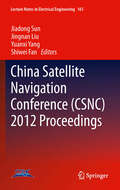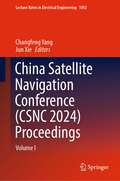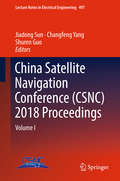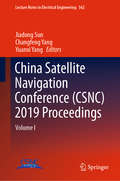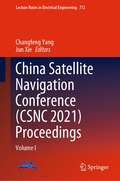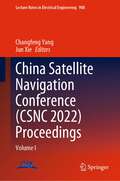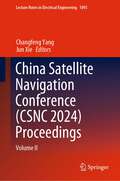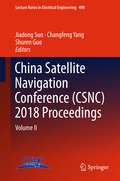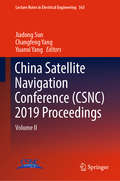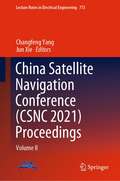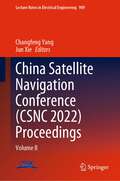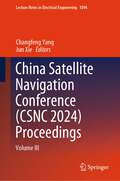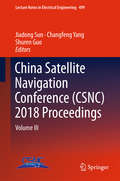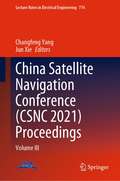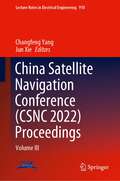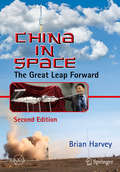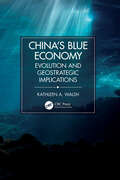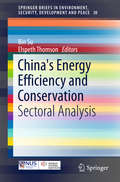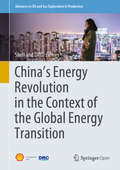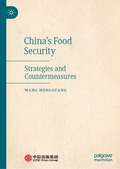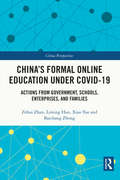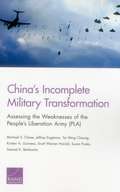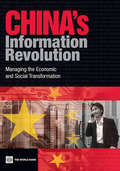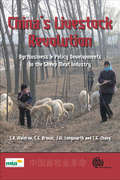- Table View
- List View
China Satellite Navigation Conference: The 3rd China Satellite Navigation Conference (csnc): Guangzhou, China, May 15-19, 2012: Revised Selected Papers (Lecture Notes in Electrical Engineering #161)
by Jiadong Sun Jingnan Liu Shiwei Fan Yuanxi YangProceedings of the 3rd China Satellite Navigation Conference (CSNC2012) presents selected research papers from CSNC2012, held on 15-19 May in Guanzhou, China. These papers discuss the technologies and applications of the Global Navigation Satellite System (GNSS), and the latest progress made in the China BeiDou system especially. They are divided into 9 topics to match the corresponding sessions in CSNC2012, which broadly covered key topics in GNSS. Readers can learn about the BeiDou system and keep abreast of the latest advances in GNSS techniques and applications. SUN Jiadong is the Chief Designer of the Compass/BeiDou system, and the Academician of Chinese Academy of Sciences; LIU Jingnan is a professor at Wuhan University, and the Academician of Chinese Academy of Engineering; YANG Yuanxi is a professor at China National Administration of GNSS and Applications, and the Academician of Chinese Academy of Sciences; FAN Shiwei is a researcher on satellite navigation.
China Satellite Navigation Conference: Volume I (Lecture Notes in Electrical Engineering #1092)
by Changfeng Yang Jun XieThis book presents selected research papers from China Satellite Navigation Conference (CSNC) 2024, held in Jinan, China, on 22–24 May 2024. These papers discuss the technologies and applications of the Global Navigation Satellite System (GNSS) and in particular the latest advances in the China BeiDou System (BDS). They are divided into 8 topics to match the corresponding sessions at CSNC 2024, which broadly covered key topics in GNSS. Readers learn about the BDS and keep abreast of the latest advances in GNSS technologies and applications.
China Satellite Navigation Conference: Volume I (Lecture Notes in Electrical Engineering #497)
by Jiadong Sun Changfeng Yang Shuren GuoThese proceedings present selected research papers from CSNC 2018, held during 23rd-25th May in Harbin, China. The theme of CSNC 2018 is Location, Time of Augmentation. These papers discuss the technologies and applications of the Global Navigation Satellite System (GNSS), and the latest progress made in the China BeiDou System (BDS) especially. They are divided into 12 topics to match the corresponding sessions in CSNC 2018, which broadly covered key topics in GNSS. Readers can learn about the BDS and keep abreast of the latest advances in GNSS techniques and applications.
China Satellite Navigation Conference: Volume I (Lecture Notes in Electrical Engineering #562)
by Jiadong Sun Yuanxi Yang Changfeng YangChina Satellite Navigation Conference (CSNC) 2019 Proceedings presents selected research papers from CSNC2019 held during 22nd-25th May in Beijing, China. These papers discuss the technologies and applications of the Global Navigation Satellite System (GNSS), and the latest progress made in the China BeiDou System (BDS) especially. They are divided into 12 topics to match the corresponding sessions in CSNC2019, which broadly covered key topics in GNSS. Readers can learn about the BDS and keep abreast of the latest advances in GNSS techniques and applications.
China Satellite Navigation Conference: Volume I (Lecture Notes in Electrical Engineering #772)
by Changfeng Yang Jun XieChina Satellite Navigation Conference (CSNC 2021) Proceedings presents selected research papers from CSNC 2021 held during 22nd-25th May, 2021 in Nanchang, China. These papers discuss the technologies and applications of the Global Navigation Satellite System (GNSS), and the latest progress made in the China BeiDou System (BDS) especially. They are divided into 10 topics to match the corresponding sessions in CSNC2021 which broadly covered key topics in GNSS. Readers can learn about the BDS and keep abreast of the latest advances in GNSS techniques and applications.
China Satellite Navigation Conference: Volume I (Lecture Notes in Electrical Engineering #908)
by Changfeng Yang Jun XieChina Satellite Navigation Conference (CSNC 2022) Proceedings presents selected research papers from CSNC 2022 held during 25th-27th May, 2022 in Beijing, China. These papers discuss the technologies and applications of the Global Navigation Satellite System (GNSS), and the latest progress made in the China BeiDou System (BDS) especially. They are divided into 10 topics to match the corresponding sessions in CSNC2022 which broadly covered key topics in GNSS. Readers can learn about the BDS and keep abreast of the latest advances in GNSS techniques and applications.
China Satellite Navigation Conference: Volume II (Lecture Notes in Electrical Engineering #1093)
by Changfeng Yang Jun XieThis book presents selected research papers from China Satellite Navigation Conference (CSNC) 2024, held in Jinan, China, on 22–24 May 2024. These papers discuss the technologies and applications of the Global Navigation Satellite System (GNSS) and in particular the latest advances in the China BeiDou System (BDS). They are divided into 8 topics to match the corresponding sessions at CSNC 2024, which broadly covered key topics in GNSS. Readers learn about the BDS and keep abreast of the latest advances in GNSS technologies and applications.
China Satellite Navigation Conference: Volume II (Lecture Notes in Electrical Engineering #498)
by Jiadong Sun Changfeng Yang Shuren GuoThese proceedings present selected research papers from CSNC 2018, held during 23rd-25th May in Harbin, China. The theme of CSNC 2018 is Location, Time of Augmentation. These papers discuss the technologies and applications of the Global Navigation Satellite System (GNSS), and the latest progress made in the China BeiDou System (BDS) especially. They are divided into 12 topics to match the corresponding sessions in CSNC 2018, which broadly covered key topics in GNSS. Readers can learn about the BDS and keep abreast of the latest advances in GNSS techniques and applications.
China Satellite Navigation Conference: Volume II (Lecture Notes in Electrical Engineering #563)
by Jiadong Sun Yuanxi Yang Changfeng YangChina Satellite Navigation Conference (CSNC) 2019 Proceedings presents selected research papers from CSNC2019 held during 22nd-25th May in Beijing, China. These papers discuss the technologies and applications of the Global Navigation Satellite System (GNSS), and the latest progress made in the China BeiDou System (BDS) especially. They are divided into 12 topics to match the corresponding sessions in CSNC2019, which broadly covered key topics in GNSS. Readers can learn about the BDS and keep abreast of the latest advances in GNSS techniques and applications.
China Satellite Navigation Conference: Volume II (Lecture Notes in Electrical Engineering #773)
by Changfeng Yang Jun XieChina Satellite Navigation Conference (CSNC 2021) Proceedings presents selected research papers from CSNC 2021 held during 22nd-25th May, 2021 in Nanchang, China. These papers discuss the technologies and applications of the Global Navigation Satellite System (GNSS), and the latest progress made in the China BeiDou System (BDS) especially. They are divided into 10 topics to match the corresponding sessions in CSNC2021 which broadly covered key topics in GNSS. Readers can learn about the BDS and keep abreast of the latest advances in GNSS techniques and applications.
China Satellite Navigation Conference: Volume II (Lecture Notes in Electrical Engineering #909)
by Changfeng Yang Jun XieChina Satellite Navigation Conference (CSNC 2022) Proceedings presents selected research papers from CSNC 2022 held during 22nd-25th May, 2022 in Beijing, China. These papers discuss the technologies and applications of the Global Navigation Satellite System (GNSS), and the latest progress made in the China BeiDou System (BDS) especially. They are divided into 10 topics to match the corresponding sessions in CSNC2022 which broadly covered key topics in GNSS. Readers can learn about the BDS and keep abreast of the latest advances in GNSS techniques and applications.
China Satellite Navigation Conference: Volume III (Lecture Notes in Electrical Engineering #1094)
by Changfeng Yang Jun XieThis book presents selected research papers from China Satellite Navigation Conference (CSNC) 2024, held in Jinan, China, on 22–24 May 2024. These papers discuss the technologies and applications of the Global Navigation Satellite System (GNSS) and in particular the latest advances in the China BeiDou System (BDS). They are divided into 8 topics to match the corresponding sessions at CSNC 2024, which broadly covered key topics in GNSS. Readers learn about the BDS and keep abreast of the latest advances in GNSS technologies and applications.
China Satellite Navigation Conference: Volume III (Lecture Notes in Electrical Engineering #499)
by Jiadong Sun Changfeng Yang Shuren GuoThese proceedings present selected research papers from CSNC 2018, held during 23rd-25th May in Harbin, China. The theme of CSNC 2018 is Location, Time of Augmentation. These papers discuss the technologies and applications of the Global Navigation Satellite System (GNSS), and the latest progress made in the China BeiDou System (BDS) especially. They are divided into 12 topics to match the corresponding sessions in CSNC 2018, which broadly covered key topics in GNSS. Readers can learn about the BDS and keep abreast of the latest advances in GNSS techniques and applications.
China Satellite Navigation Conference: Volume III (Lecture Notes in Electrical Engineering #774)
by Changfeng Yang Jun XieChina Satellite Navigation Conference (CSNC 2021) Proceedings presents selected research papers from CSNC 2021 held during 22nd-25th May, 2021 in Nanchang, China. These papers discuss the technologies and applications of the Global Navigation Satellite System (GNSS), and the latest progress made in the China BeiDou System (BDS) especially. They are divided into 10 topics to match the corresponding sessions in CSNC2021 which broadly covered key topics in GNSS. Readers can learn about the BDS and keep abreast of the latest advances in GNSS techniques and applications.
China Satellite Navigation Conference: Volume III (Lecture Notes in Electrical Engineering #910)
by Changfeng Yang Jun XieChina Satellite Navigation Conference (CSNC 2022) Proceedings presents selected research papers from CSNC 2022 held during 25th-27th May, 2022 in Beijing, China. These papers discuss the technologies and applications of the Global Navigation Satellite System (GNSS), and the latest progress made in the China BeiDou System (BDS) especially. They are divided into 10 topics to match the corresponding sessions in CSNC2022 which broadly covered key topics in GNSS. Readers can learn about the BDS and keep abreast of the latest advances in GNSS techniques and applications.
China and the Internet: Politics of the Digital Leap Forward (Politics in Asia)
by Christopher R. Hughes Gudrun WackerChina and the Internet: Politics of the Digital Leap Forward is a comprehensive assessment of the political and economic impact of information and communication technologies (ITCs) on Chinese society. It provides in-depth analyses of topics including economic development, civil and political liberties, bureaucratic politics, international relations and security studies.The book covers the aspirations of Chinese policy-makers using the Internet to achieve a 'digital leapfrog' of economic development. Avoiding technical jargon, the book is accessible to anyone interested in the social impact of the Internet and information and communication technologies, from those in academia to business and public policy-makers.
China in Space: The Great Leap Forward (Springer Praxis Books)
by Brian HarveyIn 2019, China astonished the world by landing a spacecraft and rover on the far side of the Moon, something never achieved by any country before. China had already become the world’s leading spacefaring nation by rockets launched, sending more into orbit than any other. China is now a great space superpower alongside the United States and Russia, sending men and women into orbit, building a space laboratory (Tiangong) and sending probes to the Moon and asteroids. Roadmap 2050 promises that China will set up bases on the Moon and Mars and lead the world in science and technology by mid-century.China’s space programme is one of the least well-known, but this book will bring the reader up to date with its mysteries, achievements and exciting plans. China has built a fleet of new, powerful Long March rockets, four launch bases, tracking stations at home and abroad, with gleaming new design and production facilities. China is poised to build a large, permanent space station, bring back lunar rocks, assemble constellations of communications satellites and send spaceships to Mars, the moons of Jupiter and beyond. A self-sustaining lunar base, Yuegong, has already been simulated. In space, China is the country to watch.
China's Blue Economy: Evolution and Geostrategic Implications
by Kathleen A. WalshThe United States and China are each actively pursuing development of a Blue Economy to promote greater marine, maritime, and naval capabilities through more innovative, sustainable and environmentally friendly means. This book examines China’s approach to developing a Blue Economy, compares China’s efforts to developments in the United States, analyses prospects for cooperation, and competition, and outlines strategic implications arising from China’s linkage of the Blue Economy development concept to its Maritime Silk Road initiative. An understanding of the Blue Economy as it is being pursued in China and the Indo-Pacific region is extremely relevant for academics, industry professionals, and government officials.Features Describes in detail the development of the Blue Economy concept in China over time Includes geostrategic analysis based on the author's extensive research and explains the implications of China's Blue Economy strategy for the Indo-Pacific region Discusses timely and important topics of interest to government, industry, and academic experts, both present and future Adds value to the studies, interdisciplinary collaborations, and expertise on a complex issue of strategic, technological, and economic concern Clarifies the linkages among Blue Economy, environmental and sustainable development and recognizes the importance of understanding the Blue Economy concept at a global scale This book is written for everyone interested in Blue Economy studies, those who study and practice international relations, environmental policy and development, marine policy and governance, maritime and naval strategy, international and Asian affairs, as well as Indo-Pacific security matters.
China's Energy Efficiency and Conservation: Sectoral Analysis (SpringerBriefs in Environment, Security, Development and Peace #30)
by Bin Su Elspeth ThomsonThis Brief identifies various aspects of energy challenges faced by the Chinese central/local governments, and also provides an opportunity to study how best to achieve green growth and a low-carbon transition in a developing country like China. The progress of China's carbon mitigation policies also has significant impacts on the on-going international climate change negotiations. Therefore, both policymakers and decision makers in China and other countries can benefit from studying the challenges and opportunities in China's energy development.
China's Energy Revolution in the Context of the Global Energy Transition (Advances in Oil and Gas Exploration & Production)
by Shell International B.V. The Development Research Center (DRC) of the State Council of the People’s Republic of ChinaThis open access book is an encyclopaedic analysis of the current and future energy system of the world’s most populous country and second biggest economy. What happens in China impacts the planet. In the past 40 years China has achieved one of the most remarkable economic growth rates in history. Its GDP has risen by a factor of 65, enabling 850,000 people to rise out of poverty. Growth on this scale comes with consequences. China is the world’s biggest consumer of primary energy and the world’s biggest emitter of CO2 emissions. Creating a prosperous and harmonious society that delivers economic growth and a high quality of life for all will require radical change in the energy sector, and a rewiring of the economy more widely. In China’s Energy Revolution in the Context of the Global Energy Transition, a team of researchers from the Development Research Center of the State Council of China and Shell International examine how China can revolutionise its supply and use of energy. They examine the entire energy system: coal, oil, gas, nuclear, renewables and new energies in production, conversion, distribution and consumption. They compare China with case studies and lessons learned in other countries. They ask which technology, policy and market mechanisms are required to support the change and they explore how international cooperation can smooth the way to an energy revolution in China and across the world. And, they create and compare scenarios on possible pathways to a future energy system that is low-carbon, affordable, secure and reliable.
China's Food Security: Strategies and Countermeasures
by Wang HongguangThis book makes a systematic study of the history, current situation and trend of China's food security and the global food security. COVID-19 has triggered a world food crisis. Understanding the history, current situation and trend of China's and global food security is conducive to the rational arrangement of agricultural production, food storage, scheduling and import by management departments; it is conducive to the understanding of the situation of food supply and demand; it is conducive to the rational arrangement of production and operation planning. This book systematically studies the history and experience of China's food security, analyzes the 9 major problems facing the current food security, calculates the potential food production, puts forward the strategies and countermeasures for food security in the next 20 years and puts forward 4 strategies and 8 countermeasures for ensuring food security. This book will be of great value to scholars of international relations and sinologists, and has special relevance to United Nations sustainable development goal 2, eliminating hunger.
China's Formal Online Education under COVID-19: Actions from Government, Schools, Enterprises, and Families (China Perspectives)
by Zehui Zhan Xiao Yao Liming Huo Baichang ZhongThis book investigates how schools, enterprises and families in China have coped with the formal online education in the light of government policy throughout the COVID-19 epidemic outbreak, with special focus on the problems they have encountered and possible solutions. Using grounded theory, over 1000 posts retrieved from public online forums were analyzed under a 4*4 framework, referring to four special time nodes (proposal period, exploratory period, full deployed period, exiting period) and four major subjects (government, schools, enterprises, families). The book identifies four main issues faced by massive online education during the epidemic: platform selection in proposal period, teacher training in exploratory period, resource integration in full deployed period, and flexibility of returning to schools in exiting period. These findings enlighten us with a deeper understanding of the process of online learning in an educational emergency, helping to develop best countermeasures in similar situations, as well as to provide paths to follow for other countries. The book will appeal to teachers, researchers and school administrators of the online education and education emergency management, as well as those who are interested in Chinese education during the COVID-19 outbreak in general.
China's Incomplete Military Transformation: Assessing the Weaknesses of the People's Liberation Army (PLA)
by Michael S. Chase Scott Warren Harold Samuel K. Berkowitz Jeffrey Engstrom Tai Ming Cheung Kristen A. Gunness Susan PuskaThrough extensive primary source analysis and independent analysis, this report seeks to answer a number of important questions regarding the state of China's armed forces. The authors found that the PLA is keenly aware of its many weaknesses and is vigorously striving to correct them. Although it is only natural to focus on the PLA's growing capabilities, understanding the PLA's weaknesses--and its self-assessments--is no less important.
China's Information Revolution
by Christine Zhen-Wei Qiang Christine Zhen-WeiSince 1997, China has devoted considerable resources to information and communications technology (ICT) development. China has the world's largest telecommunications market, and its information technology industry has been an engine of economic growth-growing two to three times faster than GDP over the past 10 years. E-government initiatives have achieved significant results, and the private sector has increasingly used ICT for production and service processes, internal management, and online transactions. The approaching 10-year mark provides an excellent opportunity to update the policy to reflect the evolving needs of China's economy. These needs include the challenges posed by industrialization, urbanization, upgraded consumption, and social mobility. Developing a more effective ICT strategy will help China to achieve its economic and social goals. Addressing all the critical factors is complex and requires long-term commitment. This book highlights several key issues that need to be addressed decisively in the second half of this decade, through policies entailing institutional reform, to trigger broader changes. This books is the result of 10 months of strategic research by a World Bank team at the request of China's State Council Informatization Office and the Advisory Committee for State Informatization. Drawing on background papers by Chinese researchers, the study provides a variety of domestic perspectives and local case studies and combines these perspectives with international experiences on how similar issues may have been addressed in other countries.
China's Livestock Revolution: Agribusiness and Policy Developments in the Sheep Meat Industry
by Scott Waldron Colin Brown John Longworth Zhang CungenThis book focuses on the growing sheep meat industry while drawing on associated research from other areas of the Chinese livestock section. Using this research, the authors use the sheep meat industry case study to illustrate the broader trends that apply more generally to the Chinese livestock sector, especially in the case of ruminant livestock.
